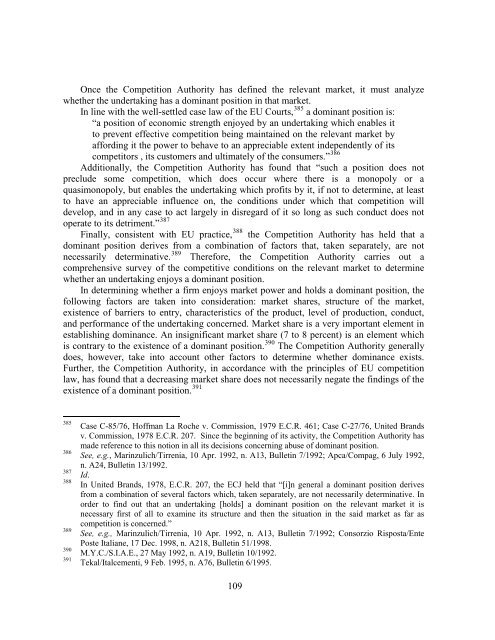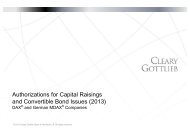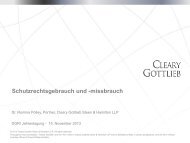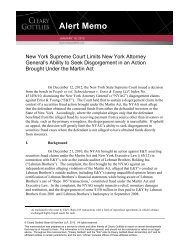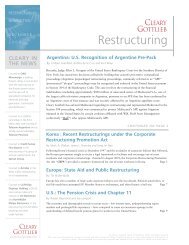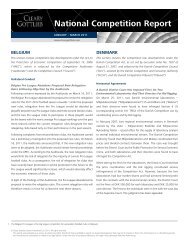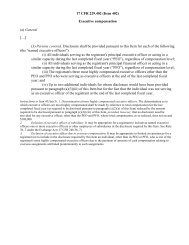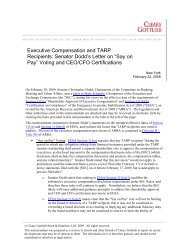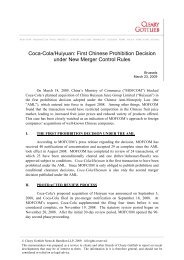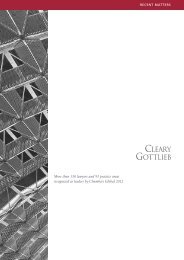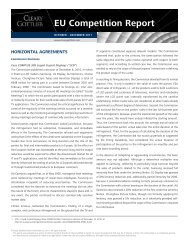Competition Law in Italy The first 20 years of law and practice
Competition Law in Italy The first 20 years of law and practice
Competition Law in Italy The first 20 years of law and practice
You also want an ePaper? Increase the reach of your titles
YUMPU automatically turns print PDFs into web optimized ePapers that Google loves.
Once the <strong>Competition</strong> Authority has def<strong>in</strong>ed the relevant market, it must analyze<br />
whether the undertak<strong>in</strong>g has a dom<strong>in</strong>ant position <strong>in</strong> that market.<br />
In l<strong>in</strong>e with the well-settled case <strong>law</strong> <strong>of</strong> the EU Courts, 385<br />
a dom<strong>in</strong>ant position is:<br />
“a position <strong>of</strong> economic strength enjoyed by an undertak<strong>in</strong>g which enables it<br />
to prevent effective competition be<strong>in</strong>g ma<strong>in</strong>ta<strong>in</strong>ed on the relevant market by<br />
afford<strong>in</strong>g it the power to behave to an appreciable extent <strong>in</strong>dependently <strong>of</strong> its<br />
386<br />
competitors , its customers <strong>and</strong> ultimately <strong>of</strong> the consumers.”<br />
Additionally, the <strong>Competition</strong> Authority has found that “such a position does not<br />
preclude some competition, which does occur where there is a monopoly or a<br />
quasimonopoly, but enables the undertak<strong>in</strong>g which pr<strong>of</strong>its by it, if not to determ<strong>in</strong>e, at least<br />
to have an appreciable <strong>in</strong>fluence on, the conditions under which that competition will<br />
develop, <strong>and</strong> <strong>in</strong> any case to act largely <strong>in</strong> disregard <strong>of</strong> it so long as such conduct does not<br />
387<br />
operate to its detriment.”<br />
388<br />
F<strong>in</strong>ally, consistent with EU <strong>practice</strong>, the <strong>Competition</strong> Authority has held that a<br />
dom<strong>in</strong>ant position derives from a comb<strong>in</strong>ation <strong>of</strong> factors that, taken separately, are not<br />
necessarily determ<strong>in</strong>ative. 389<br />
<strong>The</strong>refore, the <strong>Competition</strong> Authority carries out a<br />
comprehensive survey <strong>of</strong> the competitive conditions on the relevant market to determ<strong>in</strong>e<br />
whether an undertak<strong>in</strong>g enjoys a dom<strong>in</strong>ant position.<br />
In determ<strong>in</strong><strong>in</strong>g whether a firm enjoys market power <strong>and</strong> holds a dom<strong>in</strong>ant position, the<br />
follow<strong>in</strong>g factors are taken <strong>in</strong>to consideration: market shares, structure <strong>of</strong> the market,<br />
existence <strong>of</strong> barriers to entry, characteristics <strong>of</strong> the product, level <strong>of</strong> production, conduct,<br />
<strong>and</strong> performance <strong>of</strong> the undertak<strong>in</strong>g concerned. Market share is a very important element <strong>in</strong><br />
establish<strong>in</strong>g dom<strong>in</strong>ance. An <strong>in</strong>significant market share (7 to 8 percent) is an element which<br />
390<br />
is contrary to the existence <strong>of</strong> a dom<strong>in</strong>ant position. <strong>The</strong> <strong>Competition</strong> Authority generally<br />
does, however, take <strong>in</strong>to account other factors to determ<strong>in</strong>e whether dom<strong>in</strong>ance exists.<br />
Further, the <strong>Competition</strong> Authority, <strong>in</strong> accordance with the pr<strong>in</strong>ciples <strong>of</strong> EU competition<br />
<strong>law</strong>, has found that a decreas<strong>in</strong>g market share does not necessarily negate the f<strong>in</strong>d<strong>in</strong>gs <strong>of</strong> the<br />
existence <strong>of</strong> a dom<strong>in</strong>ant position. 391<br />
385<br />
Case C-85/76, H<strong>of</strong>fman La Roche v. Commission, 1979 E.C.R. 461; Case C-27/76, United Br<strong>and</strong>s<br />
v. Commission, 1978 E.C.R. <strong>20</strong>7. S<strong>in</strong>ce the beg<strong>in</strong>n<strong>in</strong>g <strong>of</strong> its activity, the <strong>Competition</strong> Authority has<br />
made reference to this notion <strong>in</strong> all its decisions concern<strong>in</strong>g abuse <strong>of</strong> dom<strong>in</strong>ant position.<br />
386<br />
See, e.g., Mar<strong>in</strong>zulich/Tirrenia, 10 Apr. 1992, n. A13, Bullet<strong>in</strong> 7/1992; Apca/Compag, 6 July 1992,<br />
n. A24, Bullet<strong>in</strong> 13/1992.<br />
387<br />
Id.<br />
388<br />
In United Br<strong>and</strong>s, 1978, E.C.R. <strong>20</strong>7, the ECJ held that “[i]n general a dom<strong>in</strong>ant position derives<br />
from a comb<strong>in</strong>ation <strong>of</strong> several factors which, taken separately, are not necessarily determ<strong>in</strong>ative. In<br />
order to f<strong>in</strong>d out that an undertak<strong>in</strong>g [holds] a dom<strong>in</strong>ant position on the relevant market it is<br />
necessary <strong>first</strong> <strong>of</strong> all to exam<strong>in</strong>e its structure <strong>and</strong> then the situation <strong>in</strong> the said market as far as<br />
competition is concerned.”<br />
389<br />
See, e.g., Mar<strong>in</strong>zulich/Tirrenia, 10 Apr. 1992, n. A13, Bullet<strong>in</strong> 7/1992; Consorzio Risposta/Ente<br />
Poste Italiane, 17 Dec. 1998, n. A218, Bullet<strong>in</strong> 51/1998.<br />
390<br />
M.Y.C./S.I.A.E., 27 May 1992, n. A19, Bullet<strong>in</strong> 10/1992.<br />
391<br />
Tekal/Italcementi, 9 Feb. 1995, n. A76, Bullet<strong>in</strong> 6/1995.<br />
109


